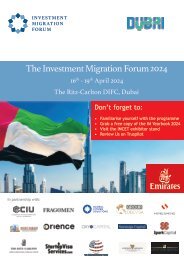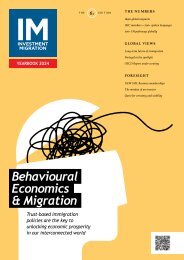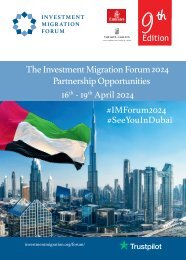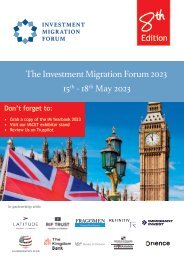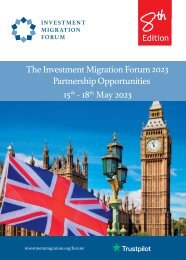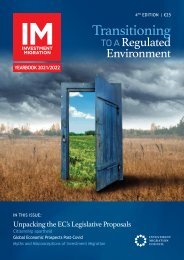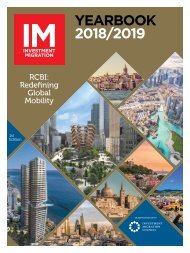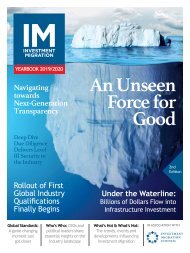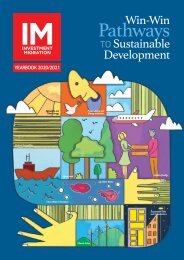IM Yearbook 2023
The completely new IM Yearbook 2023 is the 5th edition of what is now known as the most anticipated guide of the Investment Migration industry. The IM Yearbook is the essential global reference tool for the industry by the industry. Offering unrivaled valuable access to a prime targeted readership of your partners, clients and potential new business сontacts. Decision-makers in more than 54 countries trust the publication as a reputable source of information and guide. Readership includes: agents, law firms, advisory firms, banks, wealth managers, service providers, policy makers, government staffers, international organisations, and academics. Providing comprehensive, in-depth information about the global Investment Migration industry, the IM Yearbook 2023 will offer readers a practical A-Z guide to the current business operating environment while also highlighting the depth and breadth of practitioners, programmes, and their partners of all types.
The completely new IM Yearbook 2023 is the 5th edition of what is now known as the most anticipated guide of the Investment Migration industry.
The IM Yearbook is the essential global reference tool for the industry by the industry. Offering unrivaled valuable access to a prime targeted readership of your partners, clients and potential new business сontacts. Decision-makers in more than 54 countries trust the publication as a reputable source of information and guide. Readership includes: agents, law firms, advisory firms, banks, wealth managers, service providers, policy makers, government staffers, international organisations, and academics.
Providing comprehensive, in-depth information about the global Investment Migration industry, the IM Yearbook 2023 will offer readers a practical A-Z guide to the current business operating environment while also highlighting the depth and breadth of practitioners, programmes, and their partners of all types.
You also want an ePaper? Increase the reach of your titles
YUMPU automatically turns print PDFs into web optimized ePapers that Google loves.
<strong>IM</strong> YEARBOOK<br />
years will also depend on second-round<br />
effects such as the response of wages<br />
to previous price hikes as well as price<br />
adjustment policies by governments.<br />
A key player in the future evolution<br />
of inflation are central banks. Nowadays,<br />
around the world, monetary authorities<br />
are tightening monetary policy through<br />
higher interest rates to reduce inflation.<br />
The sources of inflationary pressures<br />
vary across economies. While there is<br />
some consensus that inflation in the US<br />
is largely associated with an ‘overheated’<br />
economy’ due to exaggerated levels of<br />
demand in both the goods and the labour<br />
market relative to the potential supply,<br />
it is an open question whether this is an<br />
accurate description of the economic reality<br />
of America. Low unemployment is used<br />
as an argument to back the hypothesis<br />
of “excess demand in America”.<br />
For Europe, the diagnosis is different,<br />
and it focuses on the very sharp increases<br />
in the price of gas and oil, imported from<br />
abroad, mostly Russia. Thus, a supplyshock<br />
story describes the inflationary<br />
situation in Europe better while a demandside<br />
story is more plausible for America.<br />
Among emerging economies, inflation is<br />
closely related to the energy price and food<br />
price shocks coming from international<br />
markets, so we are dealing with a mix of<br />
supply-shock and imported inflation.<br />
An impending recession?<br />
As mentioned, the <strong>IM</strong>F, the World Bank,<br />
the OECD, and the European Central<br />
Bank have all adjusted downwards<br />
their GDP growth forecasts for 2022 and<br />
<strong>2023</strong>. In turn, recessions are anticipated<br />
in <strong>2023</strong> for Germany, Italy and Russia,<br />
while the two major powerhouse<br />
of the world economy – the US and<br />
China – will experience slowdowns.<br />
The causes of the global slowdown<br />
are related to the effects of higher interest<br />
rates to fight inflation, compounded by<br />
supply energy and food price shocks<br />
and the effects of increased uncertainty<br />
affecting private investment and<br />
consumption, two main drivers of aggregate<br />
spending and economic activity.<br />
In addition, world trade has<br />
declined due to supply disruptions<br />
and new geopolitical realities, shaped<br />
by embargoes and a shift to ‘secure<br />
sources’ of supply – a major change when<br />
compared to the previous rule of “cost<br />
minimisation” that governed globalisation<br />
in the last three decades. All these<br />
factors are affecting global growth.<br />
The risk of a debt crisis<br />
During the Covid-19 crisis of 2020-21 many<br />
governments were forced to increase<br />
their levels of foreign borrowing. They<br />
needed financing to fund Covid-related<br />
support programmes set up to protect<br />
the living standards of their people who<br />
could not go to work and generate the<br />
necessary income to sustain themselves.<br />
Importantly, this borrowing was<br />
contracted, mainly in US dollars and<br />
took place at generally low interest rates.<br />
However, during 2022, macroeconomic<br />
and financial conditions have<br />
changed dramatically. A sharp rise<br />
in interest rates, a very strong dollar<br />
and portfolio capital outflows from<br />
developing nations at the periphery to<br />
advanced economies at the centre may<br />
eventually trigger a new debt crisis.<br />
For context, in the early 1980s, a very<br />
similar combination of economic factors<br />
affected the world economy following<br />
inflation stabilisation policies in the US<br />
pursued by the Federal Reserve: interest<br />
rates increased, the dollar appreciated<br />
against main world currencies and<br />
currencies of the periphery. In addition,<br />
capital flight was the norm with money<br />
flowing from economies of the global<br />
south to the US and other advanced<br />
economies. The result was the onset of a<br />
debt crisis in several large economies of<br />
Latin America, Turkey and the Philippines<br />
including forced debt rescheduling, debt<br />
cancelations and debt defaults. These<br />
episodes were also accompanied by<br />
currency crashes, recessions, dwindling<br />
investment and portfolio capital outflows.<br />
We have seen several debt crises in<br />
the last three to four decades: the East<br />
Asian crisis in 1997-98, the convertibility<br />
crisis in Argentina in 2000-01, debt<br />
stresses in Brazil in the late 1990s and<br />
the global financial crisis of 2008-09.<br />
Yet, history does not need to repeat<br />
itself. After four decades of repeated debt<br />
crises around the world there are better<br />
mechanisms to anticipate them and cope<br />
with them if they take place. Exchange<br />
rates regimes in developing countries are<br />
more flexible now than then, international<br />
reserves in the hands of central banks are<br />
higher and fiscal policy has become more<br />
ordered and predictable. Moreover, today,<br />
the <strong>IM</strong>F has in place a set of new financing<br />
instruments, several of quick disbursement,<br />
that could help avert the repeat of debt<br />
crises. However, there is little space for<br />
complacency as financial conditions are<br />
fragile even in large mature economies. Just<br />
think of the sharp decline in the value of the<br />
pound and bond prices following the Truss-<br />
Kwarteng regressive tax cut and spending<br />
increase package of late September in the<br />
UK, a policy mix that was later reversed.<br />
Investment migration<br />
An important consequence of the current<br />
economic difficulties is that the global<br />
economy is becoming more fragmented,<br />
risky, and unpredictable. How can these<br />
developments affect investment migration?<br />
Two main channels are relevant: First, in a<br />
world of heightened economic, geopolitical<br />
and security risks, an increase in the<br />
demand for investment migration is likely<br />
to follow. Option theory predicts that a<br />
vehicle, programme, or policy – think of<br />
investment migration – that enhances<br />
opportunities in risky environments carry<br />
a positive price, or insurance value.<br />
Second, governments in tough times<br />
are in increased need of foreign capital,<br />
talent, entrepreneurial capacities, and<br />
cash, and therefore will view investment<br />
migration more favourably. This already<br />
happened after the 2008-09 global financial<br />
crisis and is bound to happen again in the<br />
current circumstances. Even though, the<br />
golden years for investment migration of<br />
the 2010s might be largely over for various<br />
reasons, the economic need of countries for<br />
foreign financing, along with a personal/<br />
household demand for geographic risk<br />
diversification, remains. Therefore, it is<br />
very likely that investment migration will<br />
continue to thrive for quite a while.<br />
Dr Andrés Solimano holds a<br />
BIO Ph.D. in Economics from the<br />
Massachusetts Institute of Technology<br />
(MIT). He is the chairperson of the<br />
Investment Migration Council, as<br />
well as founder and chair of the<br />
International Centre for Globalisation<br />
and Development (CIGLOB). Previously,<br />
he served as country director at<br />
the World Bank, executive director<br />
at the Inter‐American Development<br />
Bank and director of the project on<br />
International Mobility of Talent with<br />
the United Nations University ‐ World<br />
Institute of Economic Research.<br />
Investment Migration <strong>Yearbook</strong> 2O23 - 21




